Abstract
Purpose
Rice bran is a byproduct of the hulling of rice and contains a variety of bioactive components. Various studies have reported on the antioxidative, anticancer, immune-enhancing, and hypocholesterolemic effects of rice bran. However, few studies about the physiological activity of stabilized rice bran supplement on dietary intake of sugars is limited. The aim of this study was to investigate the effect of stabilized rice bran supplement on blood glucose in C57BL/6 mice fed a high sucrose diet. Methods: Animals were randomly divided into three groups respectively, and were fed a normal diet (ND group), a high sucrose diet (HSD group) or a high sucrose diet containing 20% stabilized rice bran (HSD-SRB group) for 12 weeks. Results: In the oral glucose tolerance test (OGTT), after seven weeks of feeding on the experimental diets, a significantly lower result was observed for HSD-SRB than for HSD at 30 and 60 minutes after oral administration in glucose solution (2 g/kg body weight). The incremental area under the curve (IAUC) of HSD-SRB was significantly lower than that of HSD. After 12 weeks, fasting blood glucose level of HSD-SRB was significantly lower than that of HSD. No significant difference in the serum insulin level was observed between HSD and HSD-SRB. However, HOMA-IR was significantly decreased in HSD-SRB compared to HSD. In addition, HOMA β-cell was significantly increased in HSD-SRB compared to HSD. Triglyceride in liver of HSD-SRB was significantly lower than that of HSD. Conclusion: Feeding diets containing 20% rice bran improved insulin resistance and insulin secretion by decreasing triglyceride in liver. Thus, rice bran has a positive effect on glycemic control. In addition, the results are expected to be utilized as a basis for human study and development of food products with added rice bran.
References
1. Nguyen S, Choi HK, Lustig RH, Hsu CY. Sugar-sweetened beverages, serum uric acid, and blood pressure in adolescents. J Pediatr. 2009; 154(6):807–813.

2. James J, Kerr D. Prevention of childhood obesity by reducing soft drinks. Int J Obes (Lond). 2005; 29(Suppl 2):S54–S57.

3. Laaksonen DE, Toppinen LK, Juntunen KS, Autio K, Liukkonen KH, Poutanen KS, Niskanen L, Mykkänen HM. Dietary carbohydrate modification enhances insulin secretion in persons with the metabolic syndrome. Am J Clin Nutr. 2005; 82(6):1218–1227.

4. Moynihan P. The interrelationship between diet and oral health. Proc Nutr Soc. 2005; 64(4):571–580.

6. Lombardo YB, Drago S, Chicco A, Fainstein-Day P, Gutman R, Gagliardino JJ, Gomez Dumm CL. Long-term administration of a sucrose-rich diet to normal rats: relationship between metabolic and hormonal profiles and morphological changes in the endocrine pancreas. Metabolism. 1996; 45(12):1527–1532.

7. Oliveira LS, Santos DA, Barbosa-da-Silva S, Mandarim-de-Lacerda CA, Aguila MB. The inflammatory profile and liver damage of a sucrose-rich diet in mice. J Nutr Biochem. 2014; 25(2):193–200.

8. Saunders RM. The properties of rice bran as a foodstuff. Cereal Foods World. 1990; 35(7):): 632,. 634–636.
9. Ha TY, Ko SN, Lee SM, Kim HR, Chung SH, Kim SR, Yoon HH, Kim IH. Changes in nutraceutical lipid components of rice at different degrees of milling. Eur J Lipid Sci Technol. 2006; 108(3):175–181.

10. Kim SR, Ahn JY, Lee HY, Ha TY. Various properties and phenolic acid contents of rices and rice brans with different milling fractions. Korean J Food Sci Technol. 2004; 36(6):930–936.
11. Ishitani A, inventor; Kokai Tokkyo Koho, assignee. Oryzanol antioxidant for food. Japan Kokai Tokkyo Koho JP 80, 50, 094. 1980. (C.A.-93: 112560).
12. Newman RK, Betschart AA, Newman CW, Hofer PJ. Effect of full-fat or defatted rice bran on serum cholesterol. Plant Foods Hum Nutr. 1992; 42(1):37–43.

13. Kim SM. Effects of rice bran and phytic acid supplementation on glucose and lipid metabolism in high-fat diet-fed C57BL/6 mice [dissertation]. Daegu: Kyungpook National University;2010.
14. Park TS, Lee SY, Kim HJ, Kim KT, Kim YJ, Jeong I, Do WN, Lee HJ. Extracts of adlay, barley and rice bran have antioxidant activity and modulate fatty acid metabolism in adipocytes. Korean J Food Nutr. 2009; 22(3):456–462.
15. Justo ML, Candiracci M, Dantas AP, de Sotomayor MA, Parra-do J, Vila E, Herrera MD, Rodriguez-Rodriguez R. Rice bran enzymatic extract restores endothelial function and vascular contractility in obese rats by reducing vascular inflammation and oxidative stress. J Nutr Biochem. 2013; 24(8):1453–1461.

16. Choi HI, Ye EJ, Kim SJ, Bae MJ, Yee ST, Park EJ, Park EM. Anticancer (in vitro) and antiallergy effects of rice bran extracts. J Korean Soc Food Sci Nutr. 2006; 35(10):1297–1303.
17. Kim YH, Kang CS, Lee YS. Quantification of tocopherol and tocotrienol content in rice bran by near infrated reflectance spectroscopy. Korean J Crop Sci. 2004; 49(3):211–215.
18. Kim WJ. Quality and antioxidative activity of Garaedduk prepared with stabilized rice bran and rice flours by semi-dry milling [dissertation]. Gwangju: Chonnam National University;2013.
19. Jang KH. Effect of rice bran on the confectionery and bakery quality [dissertation]. Kyeongsan: Yeungnam University;2010.
20. Jin HJ, Lee SS. Effect of rice bran dietary fiber level on serum lipid concentration, bowel function, and mineral absorption in rats. Korean J Food Nutr. 2011; 24(4):622–629.

21. Matthews DR, Hosker JP, Rudenski AS, Naylor BA, Treacher DF, Turner RC. Homeostasis model assessment: insulin resistance and β-cell function from fasting plasma glucose and insulin concentrations in man. Diabetologia. 1985; 28(7):412–419.

22. Lo S, Russell JC, Taylor AW. Determination of glycogen in small tissue samples. J Appl Physiol. 1970; 28(2):234–236.

23. Yang M, Wang C, Chen H. Green, oolong and black tea extracts modulate lipid metabolism in hyperlipidemia rats fed high-sucrose diet. J Nutr Biochem. 2001; 12(1):14–20.

24. Kanazawa M, Xue CY, Kageyama H, Suzuki E, Ito R, Namba Y, Osaka T, Kimura S, Inoue S. Effects of a high-sucrose diet on body weight, plasma triglycerides, and stress tolerance. Nutr Rev. 2003; 61(5 Pt 2):S27–S33.

25. Madero M, Arriaga JC, Jalal D, Rivard C, McFann K, Pérez-Mé-ndez O, Vázquez A, Ruiz A, Lanaspa MA, Jimenez CR, Johnson RJ, Lozada LG. The effect of two energy-restricted diets, a low-fructose diet versus a moderate natural fructose diet, on weight loss and metabolic syndrome parameters: a randomized controlled trial. Metabolism. 2011; 60(11):1551–1559.

26. Sievenpiper JL, de Souza RJ, Mirrahimi A, Yu ME, Carleton AJ, Beyene J, Chiavaroli L, Di Buono M, Jenkins AL, Leiter LA, Wolever TM, Kendall CW, Jenkins DJ. Effect of fructose on body weight in controlled feeding trials: a systematic review and metaanalysis. Ann Intern Med. 2012; 156(4):291–304.
27. Ha TY, Lee SH, Lee HY. The effect of various rice bran extracts on the lipid contents of serum and liver in rat fed with high fat diet. Korean J Food Sci Technol. 1997; 29(1):178–182.
28. Anderson JW, Jones AE, Riddell-Mason S. Ten different dietary fibers have significantly different effects on serum and liver lipids of cholesterol-fed rats. J Nutr. 1994; 124(1):78–83.

29. Yu JR. Effect of rice bran protein on lipid metabolism in rats fed high fat diet [dissertation]. Yongin: Yongin University;2013.
30. Borkan GA, Hults DE, Gerzof SG, Robbins AH, Silbert CK. Age changes in body composition revealed by computed tomography.
31. Gutman RA, Basílico MZ, Bernal CA, Chicco A, Lombardo YB. Long-term hypertriglyceridemia and glucose intolerance in rats fed chronically an isocaloric sucrose-rich diet. Metabolism. 1987; 36(11):1013–1020.

32. Wang Y, Lam KS, Yau MH, Xu A. Post-translational modifications of adiponectin: mechanisms and functional implications. Biochem J. 2008; 409(3):623–633.

33. Kamari Y, Grossman E, Oron-Herman M, Peleg E, Shabtay Z, Shamiss A, Sharabi Y. Metabolic stress with a high carbohydrate diet increases adiponectin levels. Horm Metab Res. 2007; 39(5):384–388.

34. Tan HY, Rand JS, Morton JM, Fleeman LM, Armstrong PJ, Co-radini M, Ishioka K, Verkest KR, Richards AA, Rawlings JM, Rose FJ, Whitehead JP. Adiponectin profiles are affected by chronic and acute changes in carbohydrate intake in healthy cats. Gen Comp Endocrinol. 2011; 172(3):468–474.

35. Fuente-Martín E, García-Cáceres C, Granado M, Sánchez-Garri-do MA, Tena-Sempere M, Frago LM, Argente J, Chowen JA. Early postnatal overnutrition increases adipose tissue accrual in response to a sucrose-enriched diet. Am J Physiol Endocrinol Metab. 2012; 302(12):E1586–E1598.

36. Carvalho CR, Bueno AA, Mattos AM, Biz C, de Oliveira C, Pisani LP, Ribeiro EB, do Nascimento CM, Oyama LM. Fructose alters adiponectin, haptoglobin and angiotensinogen gene expression in 3T3-L1 adipocytes. Nutr Res. 2010; 30(9):644–649.

37. Siddiqui S, Rashid Khan M, Siddiqui WA. Comparative hypoglycemic and nephroprotective effects of tocotrienol rich fraction (TRF) from palm oil and rice bran oil against hyperglycemia induced nephropathy in type 1 diabetic rats. Chem Biol Interact. 2010; 188(3):651–658.

38. Bharti SK, Kumar A, Sharma NK, Prakash O, Jaiswal SK, Krishnan S, Gupta AK, Kumar A. Tocopherol from seeds of Cucurbita pepo against diabetes: validation by in vivo experiments supported by computational docking. J Formos Med Assoc. 2013; 112(11):676–690.
39. Torsdottir I, Alpsten M, Holm G, Sandberg AS, Tölli J. A small dose of soluble alginate-fiber affects postprandial glycemia and gastric emptying in humans with diabetes. J Nutr. 1991; 121(6):795–799.

40. Pastors JG, Blaisdell PW, Balm TK, Asplin CM, Pohl SL. Psyllium fiber reduces rise in postprandial glucose and insulin concentrations in patients with non-insulin-dependent diabetes. Am J Clin Nutr. 1991; 53(6):1431–1435.

41. Lee HS. Choi MS, Lee YK, Park SH, Kim YJ. A study on the development of high-fiber supplements for the diabetic patients: effect of seaweed supplementation on the lipid and glucose metabolism in streptozotocin-induced diabetic rats. Korean J Nutr. 1996; 29(3):296–306.
42. Swanson JE, Laine DC, Thomas W, Bantle JP. Metabolic effects of dietary fructose in healthy subjects. Am J Clin Nutr. 1992; 55(4):851–856.

43. Kuhlow D, Zarse K, Voigt A, Schulz TJ, Petzke KJ, Schomburg L, Pfeiffer AF, Ristow M. Opposing effects of dietary sugar and saturated fat on cardiovascular risk factors and glucose metabolism in mitochondrially impaired mice. Eur J Nutr. 2010; 49(7):417–427.

44. Sidossis LS, Stuart CA, Shulman GI, Lopaschuk GD, Wolfe RR. Glucose plus insulin regulate fat oxidation by controlling the rate of fatty acid entry into the mitochondria. J Clin Invest. 1996; 98(10):2244–2250.

45. Mittendorfer B, Sidossis LS. Mechanism for the increase in plasma triacylglycerol concentrations after consumption of short-term, high-carbohydrate diets. Am J Clin Nutr. 2001; 73(5):892–899.

46. Shindo N, Fujisawa T, Sugimoto K, Nojima K, Oze-Fukai A, Yoshikawa Y, Wang X, Yasuda O, Ikegami H, Rakugi H. Involvement of microsomal triglyceride transfer protein in nonalcoholic steatohepatitis in novel spontaneous mouse model. J Hepatol. 2010; 52(6):903–912.

47. Fraulob JC, Ogg-Diamantino R, Fernandes-Santos C, Aguila MB, Mandarim-de-Lacerda CA. A mouse model of metabolic syndrome: insulin resistance, fatty liver and Non-Alcoholic Fatty Pancreas Disease (NAFPD) in C57BL/6 mice fed a high fat diet. J Clin Biochem Nutr. 2010; 46(3):212–223.

48. Aguila MB, Fernandes-Santos C, Pinheiro-Mulder AR, Faria TS, Mandarim-De-Lacerda CA. Hepatic insulin resistance and nonalcoholic fatty liver disease. Molière J, Gauthier L, editors. editors.Insulin resistance: symptoms, causes, and treatment. Hauppauge (NY): Nova Science;2010. p. 1–44.
Fig. 1.
ND HSD HSD-SRB Fig. 1. Effect of stabilized rice bran on blood glucose (A) and incremental area under the curve (B) after oral glucose tolerance test in C57BL/6 mice. Values are expressed as mean ± SE. ab Different letters over the bars indicate that the mean values are significantly different (p < 0.05) by Duncan's multiple range test. ND: normal diet, HSD: high sucrose diet, HSD-SRB: high sucrose diet in which 20% dietary calorie nutrient (g) is replaced with stabilized rice bran. B
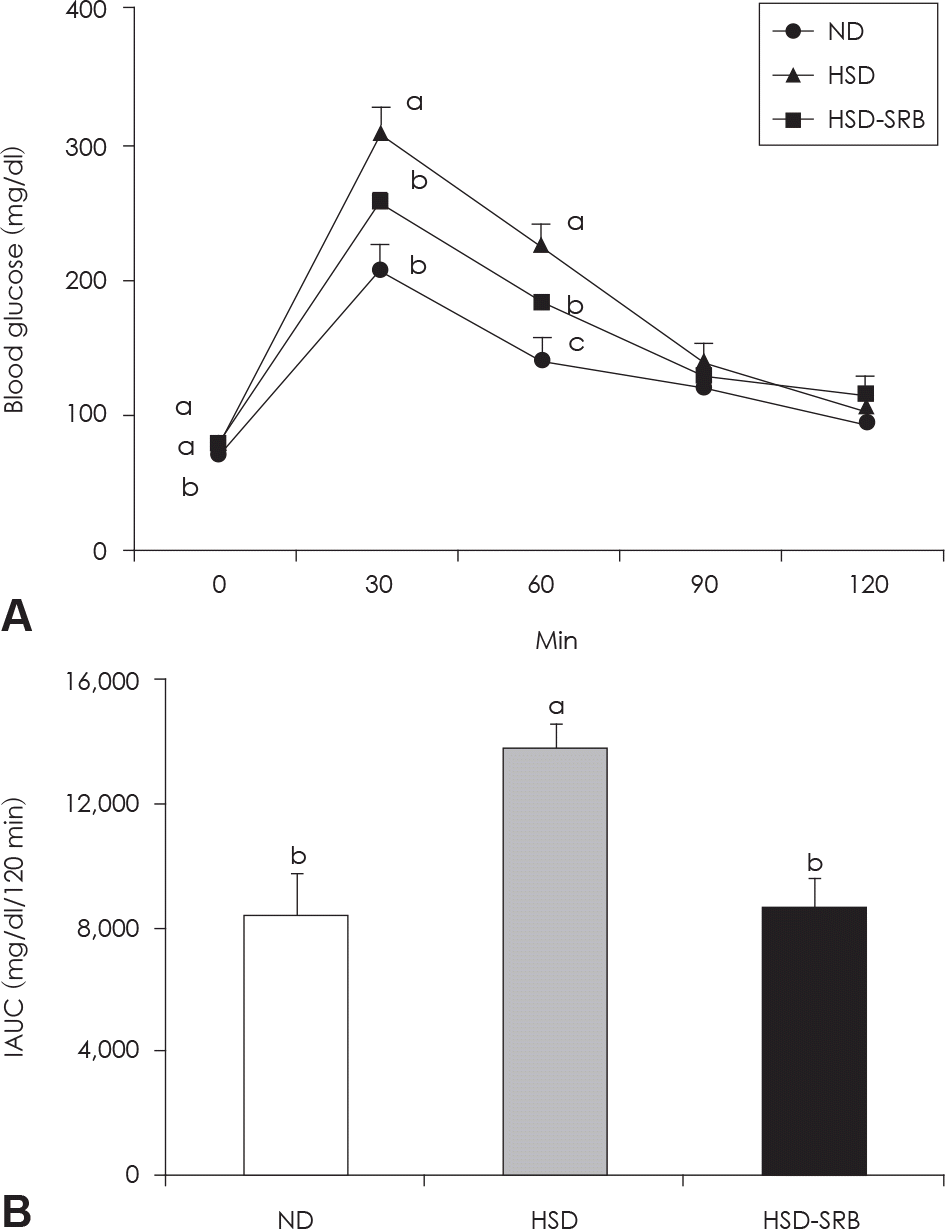
Fig. 2.
Effect of stabilized rice bran on serum insulin concentration in C57BL/6 mice. Values are expressed as mean ± SE. ND: normal diet, HSD: high sucrose diet, HSD-SRB: high sucrose diet in which 20% dietary calorie nutrient (g) is replaced with stabilized rice bran.
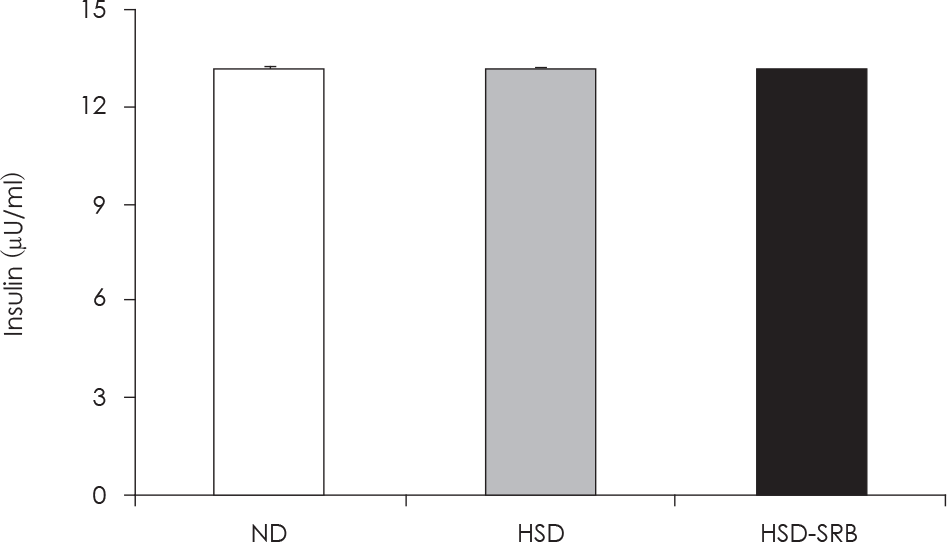
Fig. 3.
Effect of stabilized rice bran on serum adiponectin concentration in C57BL/6 mice. Values are expressed as mean ± SE. ab Different letters over the bars indicate that the mean values are significantly different (p < 0.05) by Duncan's multiple range test. ND: normal diet, HSD: high sucrose diet, HSD-SRB: high sucrose diet in which 20% dietary calorie nutrient (g) is replaced with stabilized rice bran.
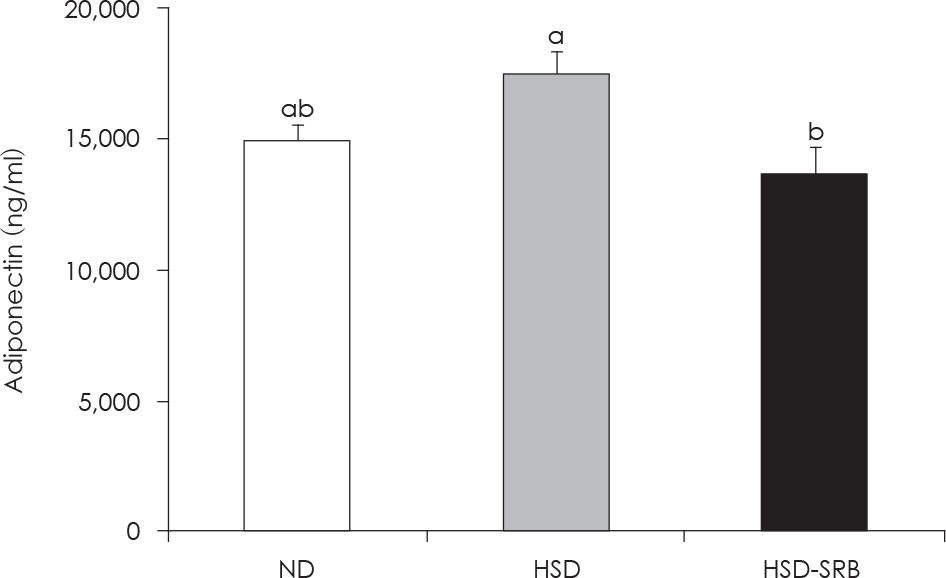
Fig. 4.
Effect of stabilized rice bran on HOMA-IR (A) and HOMA β-cell (B) in C57BL/6 mice. Values are expressed as mean ± SE. ab Different letters over the bars indicate that the mean values are significantly different (p < 0.05) by Duncan's multiple range test. ND: normal diet, HSD: high sucrose diet, HSD-SRB: high sucrose diet in which 20% dietary calorie nutrient (g) is replaced with stabilized rice bran.
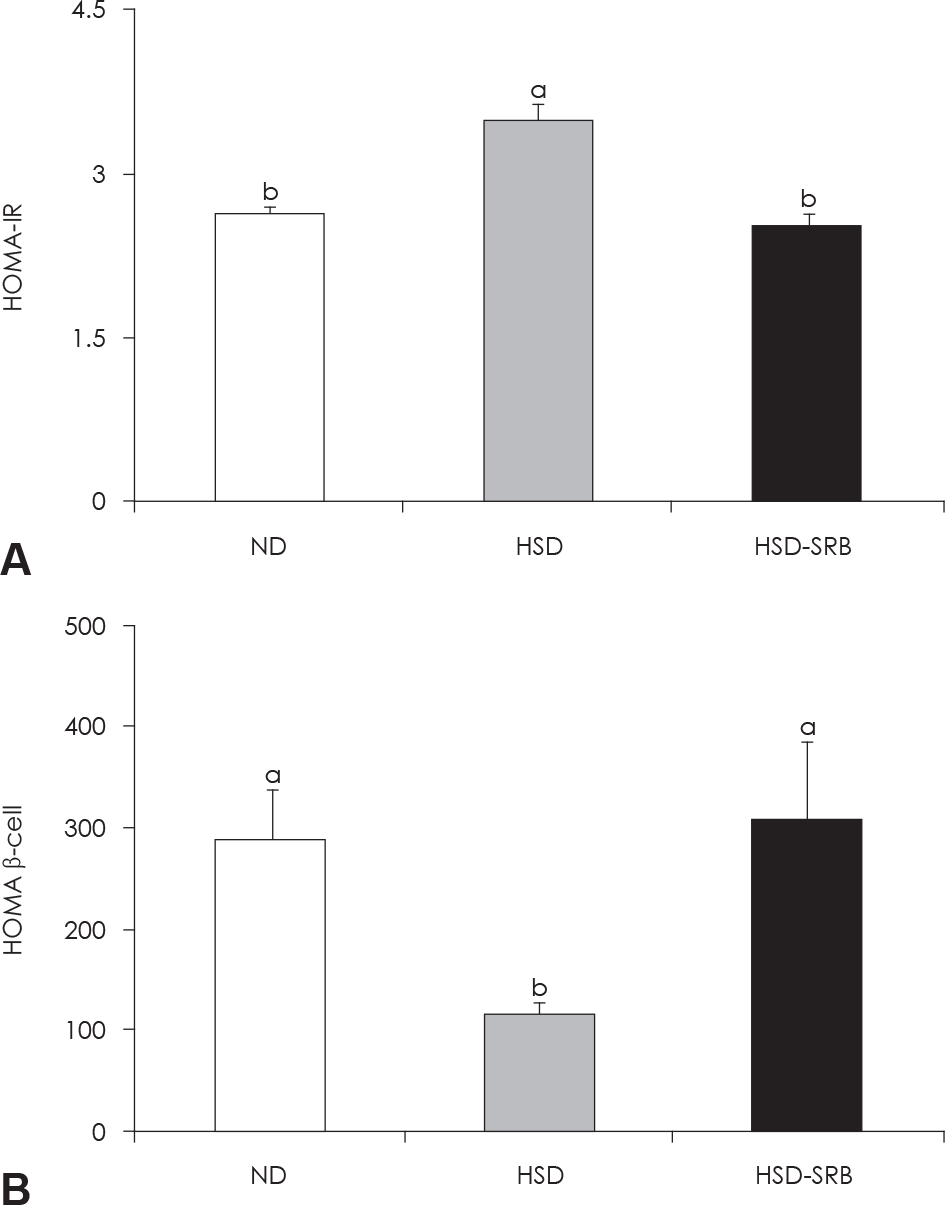
Fig. 5.
Effect of stabilized rice bran on liver glycogen concentration in C57BL/6 mice. Values are expressed as mean ± SE. ND: normal diet, HSD: high sucrose diet, HSD-SRB: high sucrose diet in which 20% dietary calorie nutrient (g) is replaced with stabilized rice bran.
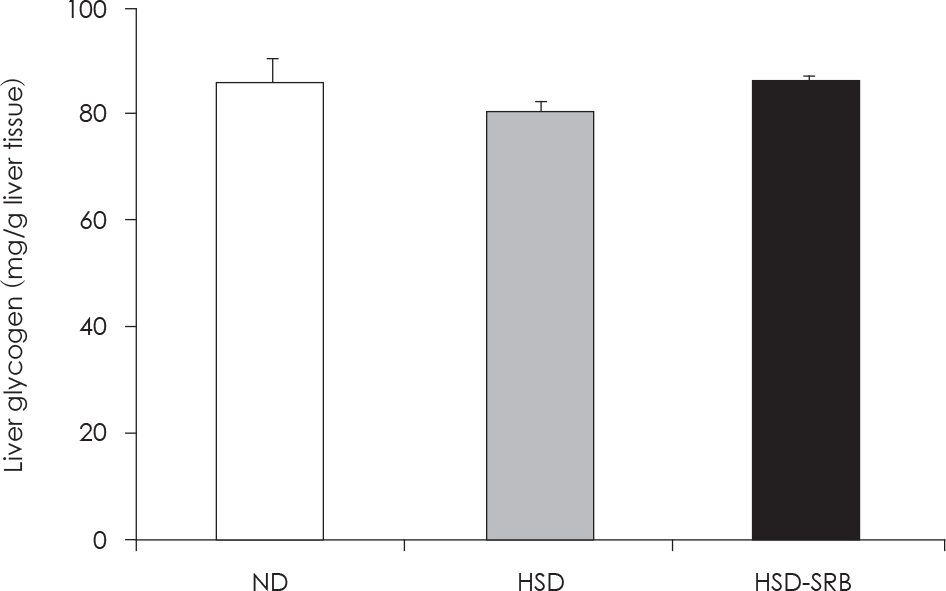
Fig. 6.
Effect of stabilized rice bran on serum (A) and liver (B) triglyceride concentration in C57BL/6 mice. Values are expressed as mean ± SE. abDifferent letters over the bars indicate that the mean values are significantly different (p < 0.05) by Duncan's multiple range test. ND: normal diet, HSD: high sucrose diet, HSD-SRB: high sucrose diet in which 20% dietary calorie nutrient (g) is replaced with stabilized rice bran.
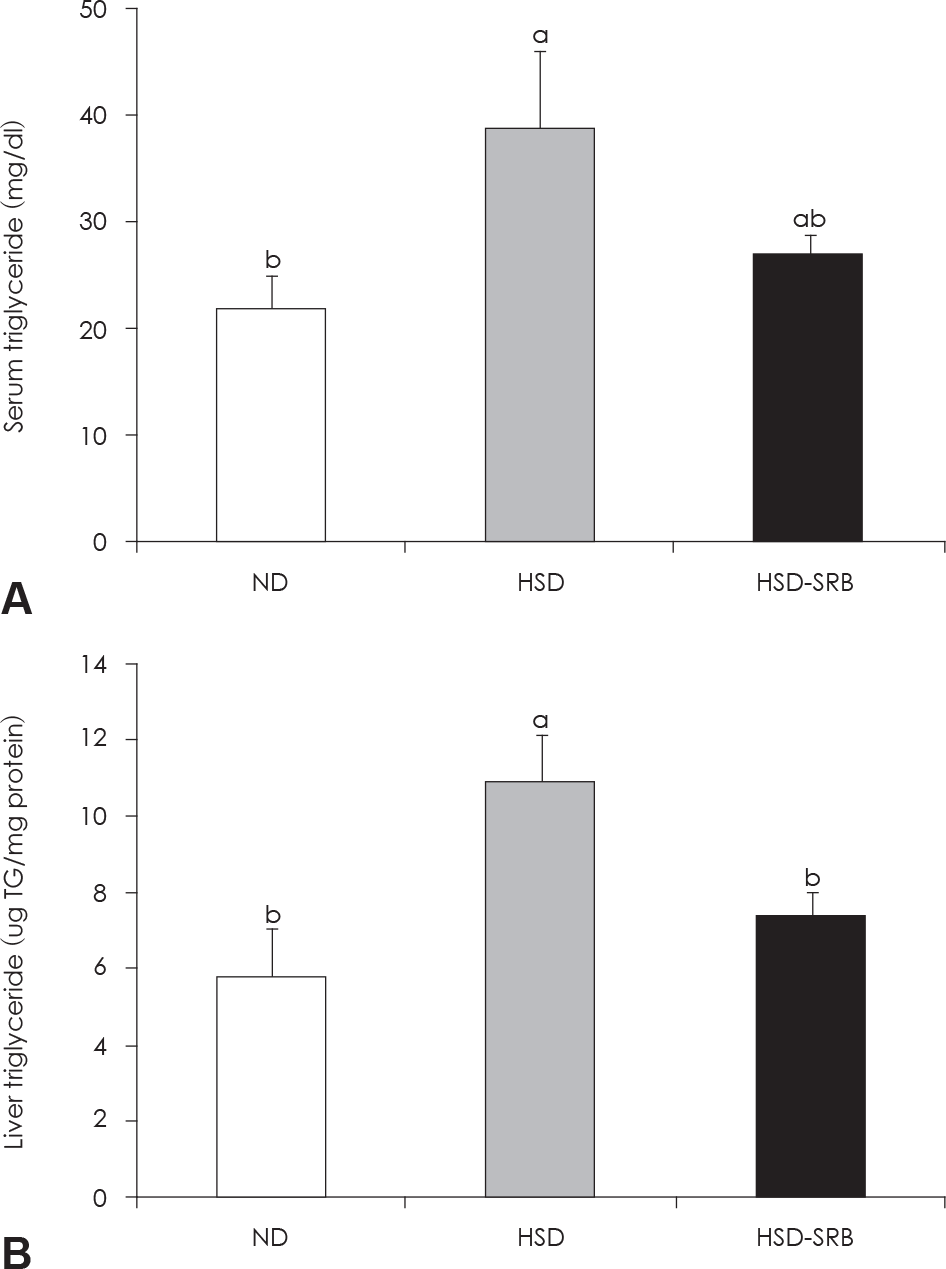
Table 1.
Composition of experimental diets
Table 2.
Effect of stabilized rice bran on body weight gain, food intake and liver weight in C57BL/6 mice
| ND | HSD | HSD-SRB | |
|---|---|---|---|
| Body weight gain (g/week) | 0.93 ± 0.04 | 0.94 ± 0.11 | 1.02 ± 0.05 |
| Food intake (g/week) | 19.97 ± 0.65b | 20.66 ± 0.78b | 24.82 ± 0.77a |
| Energy intake (kcal/week) | 319.52 ± 10.39c | 671.12 ± 25.30b | 796.27 ± 24.75a |
| Food efficiency (%) | 4.68 ± 0.22 | 4.56 ± 0.55 | 4.13 ± 0.22 |
| Liver weight (% BW) | 3.11 ± 0.11b | 3.56 ± 0.15a | 3.38 ± 0.07ab |
Table 3.
Effect of stabilized rice bran on adipose tissue weight in C57BL/6 mice
| ND | HSD | HSD-SRB | |
|---|---|---|---|
| pididymal fat pad (g) | 0.51 ± 0.06b | 0.74 ± 0.05a | 0.70 ± 0.03ab |
| erirenal fat pad (g) | 0.12 ± 0.02 | 0.22 ± 0.05 | 0.17 ± 0.02 |
| ubcutaneous fat pad (g) | 0.46 ± 0.08 | 0.70 ± 0.10 | 0.55 ± 0.10 |
| otal fat pad (g) | 1.10 ± 0.12b | 1.63 ± 0.18a | 1.42 ± 0.14ab |
| otal fat pad (% BW) | 3.96 ± 0.41b | 5.58 ± 0.43a | 4.99 ± 0.54ab |




 PDF
PDF ePub
ePub Citation
Citation Print
Print


 XML Download
XML Download